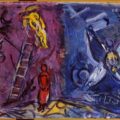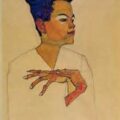The radical re-visioning of Anna Kavan

I first read Helen Ferguson/Anna Kavan in 1997 or 1998 when I was living in Ansan, an industrial city an hour subway ride from Seoul. Every few months I’d receive a catalogue that sold novels, usually unknown to me, at steep discounts, and shipped them internationally. One of the of the novels that appealed to me was Let Me Alone (1930), written by an author named Anna Kavan, an under-appreciated female writer of the twentieth century whose increasingly hallucinatory and experimental approaches to isolation, alienation, and madness made her body of work difficulty to classify. Like many initial readers, I was fascinated by Kavan’s biography—her upper-class upbringing in England, her two failed marriages, breakdowns, peripatetic wanderings, and lifelong heroin addiction, which resulted in a reinvented self: she bleached her brown hair, became waif thin, and changed her name from Helen Ferguson to Anna Kavan, the protagonist in Let Me Alone. I learned that Kavan was a revered cult figure for her 1967 novel Ice, which has recently been reissued by Penguin Classics in a 50th Anniversary edition to widespread critical acclaim.
This critical acclaim is welcome, reviving earlier assessments of Kavan’s work. Anais Nin mentions her love for Kavan in The Future of the Novel, and Kavan has long been favorably compared to Virginia Woolf, Franz Kafka, and Jean Rhys. However, the critical attention given to Ice has overshadowed Kavan’s many volumes of fiction (16 published in her lifetime, 6 more posthumously) which until recently have mostly been neglected. Then in November 2017, Women: A Cultural Review published a special feature re-evaluating Kavan’s work, providing a welcome corrective to critics’ singular focus on Ice and to the propensity to interpret her work solely in terms of the more salacious autobiographical elements. As Victoria Walker asserts in her excellent “Introduction to Anna Kavan: New Readings”:
A series of assumptions about Kavan’s writing has dominated much of the critical discourse around her work—namely, that she was solipsistic, that her work stands outside of literary movements and traditions, that she was unconcerned with class or gender politics, and that her writing was refracted through her drug addiction and madness, being, ultimately, “a constant inquiry into her own identity, and the invention of a personal mythology.”
To call Kavan’s work insular, unique, or the mere product of drug hallucinations is to ignore the continuity of early thematic concerns in her later work, to diminish her political and gender critiques, and to overlook the creative resistance of the female protagonists in her work. As Chris Morgan notes in his excellent essay on Kavan, “Those influences are present, of course, but their conjuring often paints Kavan as derivative rather than foundational.”
Kavan’s effusive, discursive, interior writing style would not meet the approval of the American Program Era’s puritanical prescriptions to avoid adjectives and adverbs and to show rather than tell. In Let Me Alone, Kavan’s sentences are a whirl of contradiction and tension, coiled in tight paragraphs that usually begin with a declarative sentence followed with a But or Yet construction that undermines her previous assertion on its way to unexpected cloture (not to closure though). These long cascading sentences with their backtracking and contradictions seem to bristle against the narrative’s conventional chronological storytelling. One typical example early in Let Me Alone is when Anna’s nanny is sent away by her father. “But Anna did not smile with him,” Kavan writes. “Dimly her immature mind was aware of tragedy in that comical dwindling figure; recognized a kind of nobility in that unromantic departure, so that she almost started to run after her, to give her some sign of appreciation and affection that she might not go away altogether uncomforted. But it was too late.”
Inwardly and outwardly, Anna the protagonist resists the constraints of the patriarchal British social system. Raised in isolation by her dissipated, aloof father (who, increasingly attracted to his prepubescent daughter, eventually commits suicide instead of raping her), playing with the “peasant” children, educated and raised like a boy, Anna’s formative years, as isolating as they are, lay the groundwork for her inner strength to resist and question mainstream society. After her father dies, Anna’s guardian, her aunt, ships her away to boarding schools. Anna’s only happy periods in the novel are during her stay at an experimental boarding school, where she forms intense (and in at least one case, romantic) relationships with three women. When she is kicked out of that school, Anna, planning to attend Oxford, must return to the conventionally upper class society of her aunt and uncle. Determined not to become a victim, Anna is ultimately defeated by the forces arrayed against her—compelled to give up her academic dreams, marry a man she finds repulsive, and move with him to Burma, one of Britain’s colonies.
When she arrives in Burma, Anna describes the country alternatively as a dream, an alien world, a delirium, a nightmare. Her world is a horror. During the day, the sinister marsh she fears becomes more benignly defamiliarizing: “it was veiled by bright sunshine: hidden behind the strangeness, the unearthly beauty of the place. For it was beautiful. The marsh itself had beauty…But at night, when the darkness took it, it was a demon in the world.” While the dark swamp reflects her horror, during the day the native Burmese “looked so happy, with a strange insouciant happiness that was fascinating to her, a happiness which belonged to some other world.”
Anna wants to communicate with the Burmese, to learn the secret of their happiness, but as a white woman, she is forbidden. At one point in the novel, Anna finds a moment of connection with a Burmese boy at the market. “How great a gulf must always divide her from him! And as she looked at him he turned his head; a sort of recognition flashed in his eyes, an acknowledgment of her…If only she could communicate with him. She felt him as a human being—one who would not humiliate her, or make demands upon her or treat her unworthily…Why, oh why, was he on the other side of the glass?” Anna’s silent connection with the boy is the only connection she has with either the British or the Burmese in the novel, and social mores restrain her from further human connection with him.
While Anna ends up liking the “strange people and the strange land,” she feels even more alienated from her life among the English. She hates the Victorian-era colonialism as mirrored through the patriarchal attitude of the men—“Never for one moment did any man treat any woman as a rational human being” —and the women’s unquestioning acquiescence. “They even seemed honoured when these super-beings bestowed their ephemeral attentions.” For Anna, these gendered roles are anathema to her being. But her husband Matthew, in his element as “the dominant, complacent male” is happy.
Burma serves to mirror Anna’s rising dislocation and alienation, and her horror. For much of their marriage, Anna resists Matthew’s sexual advances. She refuses to conform to expectation. Anna’s resistance infuriates her husband, who subsequently desires to dominate her even further. Even when Anna has lost all hope of escape, “she still remained in some part of her soul aloof and untouched. It was the hard centre of her being which never altered. Nothing could touch that.” In the final scenes of the novel, Matthew attempts to assert his mastery over Anna by raping her. After a physical altercation, Anna wins her struggle with him.
A modern reader will no doubt see the parallels between Anna’s resistance to her conqueror and Britain’s own colonialist project, as well as the perhaps Orientalist idealization of the Burmese. As George Webb of the Royal Society for Asian Affairs once wrote: “Burma’s tragedy, through every stage of British penetration from 1826 to 1948, was on the one hand to be self-centerd (sic), traditionalist, conservative, desiring only to be left alone; and on the other hand to be so situated as to be exposed to external pressures which she was powerless to repulse” (italics mine).
Toward the end of the novel, the rainy season begins. Anna, having won her battle against Matthew, wants to die to escape the nightmare of her life. She believes she is “broken and destroyed” and that there is “no cause and effect.” She returns to the house and after a feverish few days, believes that she has died, but that her body continues to live. At the end of Let Me Alone, Anna, trapped in Burma, finally accepts a visit from a high school crush named Catherine: a woman, it is suggested, who will save her from the horror of her marriage and colonialized world of Burma. Anna’s connections to women who live outside conventional society are her only escape from the horror of the violent patriarchal world, binding queer identity to a feminist and postcolonial critique of modernity.
In 1963, a radical “re” vision of the Burma section of Let Me Alone was published as Who Are You? In the decades between the publications of Let Me Alone and Who Are You? Britain’s colonialist empire had ended, Kavan’s only son had died in World War II, and the Cold War was threatening nuclear annihilation. It is not that surprising, then, that Kavan may have felt that the original ending of her early novel had been constrained and needed to be revised with a more fragmented, destabilized structure. In David Callard’s The Case of Anna Kavan: A Biography, Kavan is quoted as saying:
I wanted to abandon realistic writing insofar as it describes exclusively events in the physical environment, and to make the reader aware of the existence of the different, though just as real, “reality” which lies just beyond the surface of ordinary daily life and the surface aspect of things. I am convinced that a vast, exciting new territory is waiting to be explored by the writer in that direction.
To explore it, unconventional techniques are required. For instance, the repetition of certain incidents in the same or slightly differing forms is meant to create a three-dimensional effect—an effect in depth—and to show that there is no “absolute” reality, but that every happening will appear different at different times to different people.
By avoiding any detailed characterisation or plot, I wanted to free the reader from the actual written word, so that he would not be trapped in a piece of reportage, but stimulated to relate what is written to his own and the whole human condition, which of course is again different for each individual.
Who Are You? shows Kavan’s desire to create that three-dimensional effect. The novel follows an unnamed woman, called “the girl,” and her brutish husband, “Dog Head,” in an unnamed colonized country that resembles the Burma of Let Me Alone. It’s told from three close perspectives: the girl, Dog Head, and Khan, his devoted Muslim servant, who sees the girl as a threat to his own position in the colonial hierarchy. In the earlier novel, Matthew and Anna are given proper names while their servant, a peripheral character, is never named; in the revision, only Khan has a proper name. The colonized subjects in Let Me Alone lack voice or agency. The singular close third person narrative precludes Anna from imagining “the other” on the other side of the glass. In Who Are You? Khan’s point of view is included throughout the chapters, making his loyalty to Dog Head and his hatred of Anna clear to the reader. As Kate Houlden argues in “Queering the World or Worlding the Queer? New Readings of Anna Kavan’s Who Are You”: “From a world-literature perspective—understood to be literature of the world system—Khan and the girl’s antagonistic relationship can be viewed as the jostling of those relegated to subordinate positions at the periphery of capitalism’s reach. Dog Head, master of both, embodies the malaise of patriarchal capitalist modernity.”
Anna feels alienated from the British women who seem determined to relive the Victorian era’s colonialist constructions; likewise, the girl resists conforming to the same gendered expectations—to maintain a nice household, to socialize, to cook. Instead, she is usually reading a book, unconcerned about appearances and formalities. This resistance to the accepted norms enrages Dog Head, a more violent and menacing figure than Matthew was. As Houlden asserts, “The girl’s quiet disengagement from all that is expected of her as a colonial wife and mistress is reconfigured as resistance to the labour demanded by patriarchal capitalism, albeit with the caveat that her work is only transferred to those oppressed racially instead.”
In Let Me Alone, a casual friendship between a young married man, Whitaker, who visits Anna on his way to work, is destroyed by Matthew when he comes home one day and finds them having tea. The consequences of this triangle are elevated in Who Are You? Like Whitaker in Let Me Alone, a young man closer to Anna’s age, known as Suede Boots, visits her in the day, and becomes her only friend. While Whitaker, described as chubby, shy, and infantile, is easily quashed by Matthew, Suede Boots (replacing Catherine’s savior role in the first novel) is single, attractive, and critical of Dog Head. Dog Head discovers them having tea together and banishes him in a more dramatic encounter.
In both novels the first storm of the rainy season marks the final pages, as does a violent encounter with the husband. In the first novel, Matthew traps and assaults Anna, suffering no real consequences for his violence; in the revision, Dog Head’s rape of the girl results in a deathly punishment. In a hallucinatory passage, the girl escapes after the rape, although her fate is unknown, while Dog Head, feverish and drunk, battles a large rat (the legendary rat king that appears to wrong-doers during the monsoon). He finally dies under a wardrobe that falls and crushes him.
Kavan doesn’t end the novel there, however. Instead she pens a third ending, one that returns to the day Dog Head discovers the girl and Suede Boots taking tea. In this ending, the girl has told Suede Boots that she’d like to relive her first encounter with him. “You can’t be tied down to a predestined fate,” she says, “when you change according to your situation and your fate must change,” a restatement of Kavan’s own artistic aesthetic. In this version, after Dog Head humiliates Suede Boots and sends him away, Suede Boots offers the girl an opportunity to escape her oppression. The girl accepts his offer, in an echo of the ending in Let Me Alone.
It’s rare that an author would publish three different narrative conclusions to the same basic story. By doing so, Kavan reveals the power of re-vision, of offering new resolutions to old problems.
It is a mistake to dismiss the Helen Ferguson-era “realistic” novels such as Let Me Alone as inconsequential, as some have done, assuming that they bear little relation to her later experimental work. The concerns of her earlier novels pre-figure contemporary realistic works such as Edward St. Aubyn’s Patrick Melrose series, which also details narcissistic and sociopathic parents, alienation, drug addiction, incest, and rape among a dissipated British upper class. The hallucinatory Burmese landscape in Let Me Alone foreshadows the hallucinatory passages Kavan will become known for in her later works. The alternate and multiple realities in that novel allow for a destabilization of the hegemonic order. As the neuroscientist David Eagleman says, “Of course, sometimes it’s quite difficult to know if you’re hallucinating. You might hallucinate a silver pen on your desk right now and never suspect it’s not real—because its presence is plausible. It’s easy to spot a hallucination only when it’s bizarre. For all we know, we hallucinate all the time.”
The novel also highlights the instability of memories in the way they reflect our subjective realities. As I re-read Let Me Alone for this essay, I found I had misremembered the novel as mostly taking place in Burma, so I was surprised to find out that the Burma section occupies only the final sixth of the novel. In fact, most of the novel takes place in England. But this misremembering points to my own revision of the novel, and how as readers we are often revising and misremembering what we’ve read and experienced.
No doubt continued re-readings of Kavan’s work will yield more discoveries. While Kavan has been positively associated with Rhys, Woolf, and Djuna Barnes, I would compare her work to that of the New Zealand writer Janet Frame, who also wrote about her breakdowns and institutionalizations. Frame’s work runs the range from realistic (Owls Do Cry) to the fantastic (The Edge of the Alphabet). She too explores the alienation and “homelessness of the self,” as well as the themes of madness and imprisonment. Like Kavan, whose work is sometimes explained as an outcome of her heroin addiction, Frame’s talent was at first explained by an erroneous schizophrenia diagnosis. After her death, an article suggested that Frame was on the autism spectrum, as if some kind of medical diagnosis was still needed to explain her genius. Some critics have a hard time accepting that women writers don’t need diagnoses to explain their wild visions of the world.
In his discussion of Viktor Shklovsky’s “On Defamiliarization,” AD Jameson notes, “Art is art because it shakes us out of our complacency, reminding us that we are alive and that things don’t have to be the way they are…it is the job of the artist, therefore, to imagine what exists outside of prescribed reality.” There is no doubt that Kavan took her “job” as an artist very seriously. By radically re-visioning her life and her art, Kavan performs a personal and literary response to a violent masculine-dominated world, in which any deviation from the stable order requires the explanation of psychosis or addiction. She was compelled to continually re-vision the world she created as well as the one she lived in, to produce as many imaginative alternatives as possible, to resist and undermine attempts to reduce her to a singular self, a singular story, a singular outcome.
In her work, Kavan revisited over and over one of her central obsessions—women isolated and bullied by strong, brutish men—as she tries to imagine different narrative possibilities, which would allow different ways of living in the world.
About Sybil Baker
Sybil’s most recent novel Apparitions, received the IPPY Gold Medal for short fiction. She is the author of five works of fiction, which have won Eric Hoffer, Foreword, and IPPY awards. Her nonfiction work, Immigration Essays, was the 2018-2019 Read2Achieve selection for the University of Tennessee at Chattanooga and required reading for all first-year students. Her work has appeared in a variety of publications including Guernica, Electric Literature, Glimmer Train, and The Critical Flame. She was awarded two MakeWork Artist Grants and a 2017 Individual Artist’s Fellowship in nonfiction from the Tennessee Arts Commission. She is a professor of English at the University of Tennessee and Chattanooga, Director of the Meacham Writer’s Workshop, and on faculty for the Yale Writer’s Workshop.





